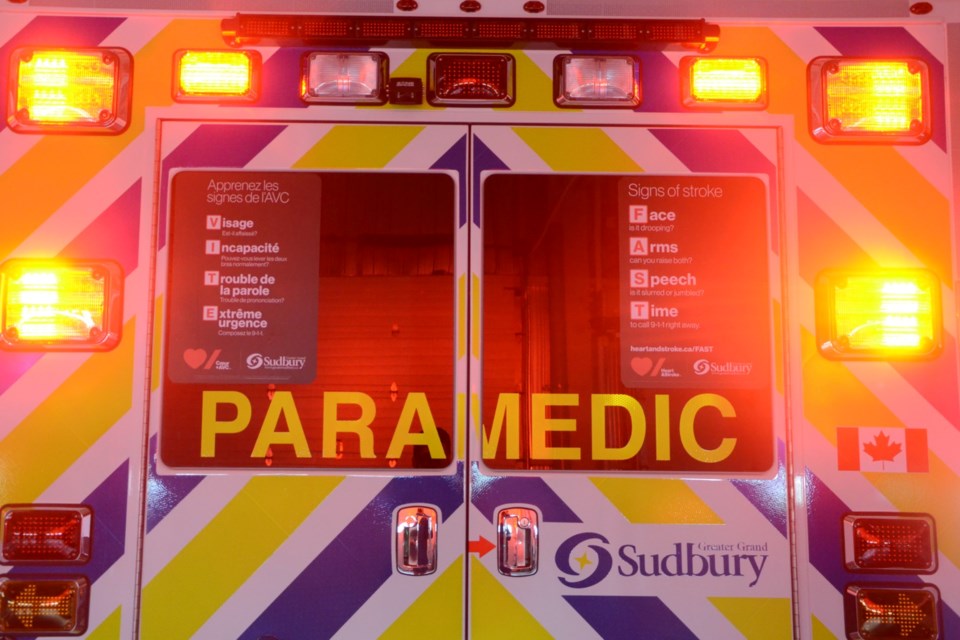With some new measures in place, including two additional 12-hour ambulance shifts, Greater Sudbury paramedics’ response times to the highest-acuity calls have been improving.
Last year, sudden cardiac arrest calls (patient has no vital signs) were responded to within the six-minute target time 65 per cent of the time.
Although short of the city’s 70-per-cent target, it’s an improvement from the 60 per cent recorded in both 2023 and 2022.
Last year saw 78 per cent of Canadian Triage Acuity Scale (CTAS) 1 (highest acuity behind sudden cardiac arrest) calls responded to within eight minutes, which is just shy of the 80-per-cent target and an improvement from the 74 per cent recorded in 2023.
Responses to CTAS 2 calls were within 10 minutes 83 per cent of the time, which was slight improvement on the 82-per-cent recorded in 2023 but still shy of the 85-per-cent target.
CTAS 3-5 calls were all responded to within the 15-minute target between 92-95 per cent of the time, which was well clear of the city’s 85-per-cent target.
In a recent presentation to city council members, Greater Sudbury Paramedic Services deputy chief Paul Kadwell cited the city’s addition of two 12-hour ambulance shifts in 2023 with improving response times.
Recent years’ challenges to meet response time targets “have been attributed to rising call volume, geographical factors, ambulance offload delays and limited paramedic resources,” he explained, citing the addition of two ambulance shifts with assisting in some of these regards.
Call volume saw a 17-per-cent rise in calls for service during the past five years, from 28,147 to 33,108, during which time patient transports increased by 30 per cent.
“The increase in calls for service over the past five years is primarily driven by aging demographics, which ultimately strains the hospital system and contributes to ambulance offload delays,” according to Kadwell’s report.
Ambulance offload delays are just that; delays in offloading patients at Health Science North which keep paramedics at the hospital while they wait for other medical professionals to take over.
These delays decreased by 12 per cent last year, from paramedics spending approximately 7,072 hours at the hospital on ambulance offload delays in 2023 and 6,236 in 2024.
The province contributed nearly $580,000 toward a dedicated offloading nurse at Health Sciences North this year to help patients brought in by ambulance. This longstanding program has been enhanced by the introduction of paramedics at the hospital to increase capacity.
On May 27, 2024, a non-urgent transportation unit funded by the province began operations as part of a two-year pilot program, and by the end of the year had completed 1,048 non-urgent transfers which would have otherwise been handled by Greater Sudbury Paramedic Services.
Instances of code zero cases (when there are no ambulances to respond to emergency calls) decreased from 73 in 2023 to 66 in 2024. The average event length of a code zero in 2023 was 35 minutes, compared to 32 minutes in 2024.
This is part of a longer-term decrease in code zero instances, with 143 recorded in 2022.
During these calls, various steps are made to ensure the most-urgent medical calls are still responded to, Kadwell explained to Sudbury.com late last year, clarifying that crews are called in from other areas to cover their most crucial calls whenever the service hits capacity.
Fire and Paramedic Services Chief Joseph Nicholls said that 100 per cent of high-acuity calls in which paramedics don’t meet response time targets are investigated, and, “where we can make changes we certainly do.”
In some cases, incidents take place in remote areas of the municipality where response time targets are impossible to meet.
Kadwell said that he anticipates further improvements to response times when a new dispatch system called the Medical Priority Dispatch System will come into play, which some ambulance communications centres in Ontario already use.
“We anticipate that it will have a positive impact on resource deployment and improve response times,” he said.
The dispatch system is a triage tool that helps dispatchers more consistently prioritize calls based on urgency.
Kadwell’s report notes that the program “changes how calls are prioritized based on their urgency, provide better information to responding paramedics, and improve response for true emergencies.”
The city’s deployment strategy will be reevaluated when the new system comes into force, but until then Kadwell said they’d maintain the “very aggressive targets compared to other services in the province” when it comes to response times.
Sudden cardiac arrest calls targets (six minutes at least 70 per cent of the time) and CTAS 1 targets (eight minutes at least 80 per cent of the time) are set by the province. CTAS 2-5 targets (10 minutes for CTAS 2, 15 minutes for CTAS 3-5, all at least 85 per cent of the time) are set by the city.
Tyler Clarke covers city hall and political affairs for Sudbury.com.




